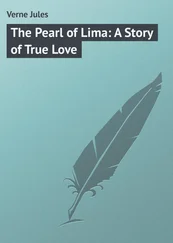But more was to come, when, with a rush through clouds of bone dust, he laid his hand upon a bare skull, and cried with a voice trembling with excitement:
“Axel! Axel! a human head!”
“A human skull?” I cried, no less astonished.
“Yes, nephew. Aha! M. Milne-Edwards! Ah! M. de Quatrefages, how I wish you were standing here at the side of Otto Liedenbrock!”
THE PROFESSOR IN HIS CHAIR AGAIN
Table of Contents
To understand this apostrophe of my uncle’s, made to absent French savants, it will be necessary to allude to an event of high importance in a palæontological point of view, which had occurred a little while before our departure.
On the 28th of March, 1863, some excavators working under the direction of M. Boucher de Perthes, in the stone quarries of Moulin Quignon, near Abbeville, in the department of Somme, found a human jawbone fourteen feet beneath the surface. It was the first fossil of this nature that had ever been brought to light. Not far distant were found stone hatchets and flint arrow-heads stained and encased by lapse of time with a uniform coat of rust.
The noise of this discovery was very great, not in France alone, but in England and in Germany. Several savants of the French Institute, and amongst them MM. Milne-Edwards and de Quatrefages, saw at once the importance of this discovery, proved to demonstration the genuineness of the bone in question, and became the most ardent defendants in what the English called this ‘trial of a jawbone.’ To the geologists of the United Kingdom, who believed in the certainty of the fact - Messrs. Falconer, Busk, Carpenter, and others - scientific Germans were soon joined, and amongst them the forwardest, the most fiery, and the most enthusiastic, was my uncle Liedenbrock.
Therefore the genuineness of a fossil human relic of the quaternary period seemed to be incontestably proved and admitted.
It is true that this theory met with a most obstinate opponent in M. Elie de Beaumont. This high authority maintained that the soil of Moulin Quignon was not diluvial at all, but was of much more recent formation; and, agreeing in that with Cuvier, he refused to admit that the human species could be contemporary with the animals of the quaternary period. My uncle Liedenbrock, along with the great body of the geologists, had maintained his ground, disputed, and argued, until M. Elie de Beaumont stood almost alone in his opinion.
We knew all these details, but we were not aware that since our departure the question had advanced to farther stages. Other similar maxillaries, though belonging to individuals of various types and different nations, were found in the loose grey soil of certain grottoes in France, Switzerland, and Belgium, as well as weapons, tools, earthen utensils, bones of children and adults. The existence therefore of man in the quaternary period seemed to become daily more certain.
Nor was this all. Fresh discoveries of remains in the pleiocene formation had emboldened other geologists to refer back the human species to a higher antiquity still. It is true that these remains were not human bones, but objects bearing the traces of his handiwork, such as fossil leg-bones of animals, sculptured and carved evidently by the hand of man.
Thus, at one bound, the record of the existence of man receded far back into the history of the ages past; he was a predecessor of the mastodon; he was a contemporary of the southern elephant; he lived a hundred thousand years ago, when, according to geologists, the pleiocene formation was in progress.
Such then was the state of palæontological science, and what we knew of it was sufficient to explain our behaviour in the presence of this stupendous Golgotha. Any one may now understand the frenzied excitement of my uncle, when, twenty yards farther on, he found himself face to face with a primitive man!
It was a perfectly recognisable human body. Had some particular soil, like that of the cemetery St. Michel, at Bordeaux, preserved it thus for so many ages? It might be so. But this dried corpse, with its parchment-like skin drawn tightly over the bony frame, the limbs still preserving their shape, sound teeth, abundant hair, and finger and toe nails of frightful length, this desiccated mummy startled us by appearing just as it had lived countless ages ago. I stood mute before this apparition of remote antiquity. My uncle, usually so garrulous, was struck dumb likewise. We raised the body. We stood it up against a rock. It seemed to stare at us out of its empty orbits. We sounded with our knuckles his hollow frame.
After some moments’ silence the Professor was himself again. Otto Liedenbrock, yielding to his nature, forgot all the circumstances of our eventful journey, forgot where we were standing, forgot the vaulted cavern which contained us. No doubt he was in mind back again in his Johannæum, holding forth to his pupils, for he assumed his learned air; and addressing himself to an imaginary audience, he proceeded thus:
“Gentlemen, I have the honour to introduce to you a man of the quaternary or post-tertiary system. Eminent geologists have denied his existence, others no less eminent have affirmed it. The St. Thomases of palæontology, if they were here, might now touch him with their fingers, and would be obliged to acknowledge their error. I am quite aware that science has to be on its guard with discoveries of this kind. I know what capital enterprising individuals like Barnum have made out of fossil men. I have heard the tale of the kneepan of Ajax, the pretended body of Orestes claimed to have been found by the Spartans, and of the body of Asterius, ten cubits long, of which Pausanias speaks. I have read the reports of the skeleton of Trapani, found in the fourteenth century, and which was at the time identified as that of Polyphemus; and the history of the giant unearthed in the sixteenth century near Palermo. You know as well as I do, gentlemen, the analysis made at Lucerne in 1577 of those huge bones which the celebrated Dr. Felix Plater affirmed to be those of a giant nineteen feet high. I have gone through the treatises of Cassanion, and all those memoirs, pamphlets, answers, and rejoinders published respecting the skeleton of Teutobochus, the invader of Gaul, dug out of a sandpit in the Dauphiné, in 1613. In the eighteenth century I would have stood up for Scheuchzer’s preadamite man against Peter Campet. I have perused a writing, entitled Gigan -“
Here my uncle’s unfortunate infirmity met him - that of being unable in public to pronounce hard words.
“The pamphlet entitled Gigan -“
He could get no further.
“Giganteo -“
It was not to be done. The unlucky word would not come out. At the Johannæum there would have been a laugh.
“Gigantosteologie,” at last the Professor burst out, between two words which I shall not record here.
Then rushing on with renewed vigour, and with great animation:
“Yes, gentlemen, I know all these things, and more. I know that Cuvier and Blumenbach have recognised in these bones nothing more remarkable than the bones of the mammoth and other mammals of the post-tertiary period. But in the presence of this specimen to doubt would be to insult science. There stands the body! You may see it, touch it. It is not a mere skeleton; it is an entire body, preserved for a purely anthropological end and purpose.”
I was good enough not to contradict this startling assertion.
“If I could only wash it in a solution of sulphuric acid,” pursued my uncle, “I should be able to clear it from all the earthy particles and the shells which are incrusted about it. But I do not possess that valuable solvent. Yet, such as it is, the body shall tell us its own wonderful story.”
Читать дальше












